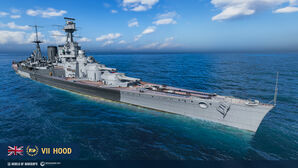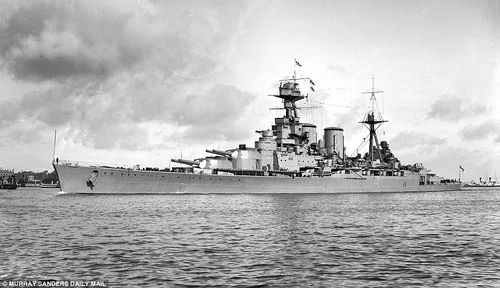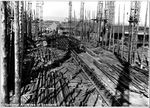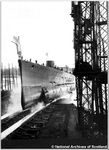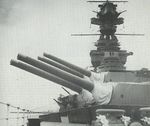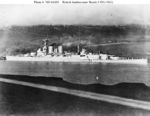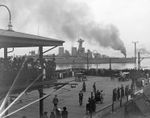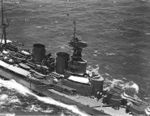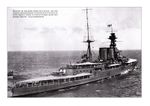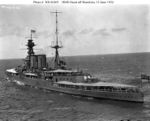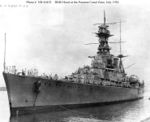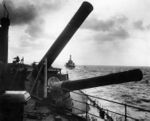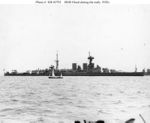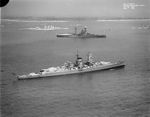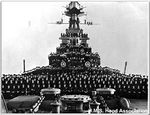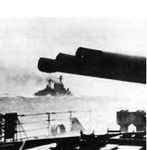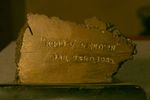Hood
| Revision as of 17:44, 18 May 2017 | Revision as of 18:12, 18 May 2017 Fixed typos, added paragraph to historical section, re-ordered historical photos. | |||
| Line 10: | Line 10: | |||
| Armament-wise, ''Hood'' has the same 15-inch/42 caliber guns as ''[[Warspite]]'' has, with slightly faster turret traverse and higher range. Unfortunately for ''Hood'', these particular guns — while potent at Tier VI — start to feel a bit underwhelming at Tier VII as other ships gain larger and/or faster-firing main battery armaments. The weak penetration values of her armor piercing rounds means captains must be careful with their aim or ''Hood''’s shells will easily bounce off of the belt armor of opposing battleships. Her armor scheme is notably lacking compared to her contemporaries at Tier VII as well, but her speed allows her to dictate the terms of an engagement against most any other battleship she is likely to face. | Armament-wise, ''Hood'' has the same 15-inch/42 caliber guns as ''[[Warspite]]'' has, with slightly faster turret traverse and higher range. Unfortunately for ''Hood'', these particular guns — while potent at Tier VI — start to feel a bit underwhelming at Tier VII as other ships gain larger and/or faster-firing main battery armaments. The weak penetration values of her armor piercing rounds means captains must be careful with their aim or ''Hood''’s shells will easily bounce off of the belt armor of opposing battleships. Her armor scheme is notably lacking compared to her contemporaries at Tier VII as well, but her speed allows her to dictate the terms of an engagement against most any other battleship she is likely to face. | |||
| ? | As a battlecruiser, ''Hood'' is significantly faster than many of the better-armored battleships at her tier and has a decent rudder shift speed, granting her the ability to dart around the battlefield with relative ease. Unique among battleships, ''Hood'' also has access to the [[Ship:Consumables#Defensive AA Fire|Defensive AA Fire]] consumable. Unlike the version available to cruisers and destroyers, however, the version available to ''Hood'' only affects her rocket launchers: her innermost AA bubble. The upside is that it multiplies their AA damage per second by 2500% (rather than the standard 300%). This means that the low range area of the rockets’ AA field becomes an instant death zone for enemy planes, but | + | As a battlecruiser, ''Hood'' is significantly faster than many of the better-armored battleships at her tier and has a decent rudder shift speed, granting her the ability to dart around the battlefield with relative ease. Unique among battleships, ''Hood'' also has access to the [[Ship:Consumables#Defensive AA Fire|Defensive AA Fire]] consumable. Unlike the version available to cruisers and destroyers, however, the version available to ''Hood'' only affects her rocket launchers: her innermost AA bubble. The upside is that it multiplies their AA damage per second by 2500% (rather than the standard 300%). This means that the low range area of the rockets’ AA field becomes an instant death zone for enemy planes, but is not useful to defend teammates. Enemy torpedo bombers may also drop outside of the effective range of the rockets as well. | |
| ''Hood'' is a solid Tier VII battleship for captains who prefer to flex their ship's speed and maneuverability to set the terms of an engagement rather than slug it out at close range. | ''Hood'' is a solid Tier VII battleship for captains who prefer to flex their ship's speed and maneuverability to set the terms of an engagement rather than slug it out at close range. | |||
| Line 176: | Line 176: | |||
| [[File:HMS_Hood_in_1918_1.jpg|500px]] | [[File:HMS_Hood_in_1918_1.jpg|500px]] | |||
| ====Design==== | ====Design==== | |||
| ? | The inception of what was to become HMS ''Hood'' began as a request to the Director of Naval Construction to design a class of ships that would succeed the ''[[Warspite|Queen Elizabeth]]''-class super dreadnoughts and would incorporate the latest design of underwater torpedo protection. After a few proposed designs, an intervention by Admiral Jellicoe | + | The inception of what was to become HMS ''Hood'' began as a request to the Director of Naval Construction to design a class of ships that would succeed the ''[[Warspite|Queen Elizabeth]]''-class super dreadnoughts and would incorporate the latest design of underwater torpedo protection. After a few proposed designs, an intervention by Admiral of the Fleet John Jellicoe — First Sea Lord of the Royal Navy — argued a change of the design to that of a battlecruiser in order to provide a response to the new ''Mackensen''-class battlecruisers being constructed by the Imperial German Navy at the time. After a second round of design proposals that prioritized speed over protection, design “No. 2” as it was known, became selected as the plan for the ''Admiral''-class battlecruisers we know today. | |
| HMS ''Hood'' was planned at 860 feet in length: a long ship by design, as there was an emphasis on hull elongation in order to reduce the draft of the ship. The goal was to improve underwater integrity and to increase her freeboard, with the intent of making her a more stable artillery platform. Additionally, she incorporated the new design of anti-torpedo blisters approved by the Admiralty. A two-layer system — an outer layer filled with air, and inner layer filled with crushing tubes — was utilized in order to both absorb and spread out the shock of explosions. For additional torpedo protection, these blisters were positioned over the fuel oil tanks, which were designed watertight and separate from the rest of the ship. As initially designed, ''Hood'' was to have eight (8) inches of sloped main belt armor and one-and-a-half (1.5) to two (2) inches of horizontal protection to match the survivability of the ''Queen Elizabeth'' class. The outcome of the Battle of Jutland necessitated a redesign of ''Hood''’s armor protection. Her belts and barbettes were increased to twelve (12) inches, and her primary decks were increased to three (3) inches of thickness. | HMS ''Hood'' was planned at 860 feet in length: a long ship by design, as there was an emphasis on hull elongation in order to reduce the draft of the ship. The goal was to improve underwater integrity and to increase her freeboard, with the intent of making her a more stable artillery platform. Additionally, she incorporated the new design of anti-torpedo blisters approved by the Admiralty. A two-layer system — an outer layer filled with air, and inner layer filled with crushing tubes — was utilized in order to both absorb and spread out the shock of explosions. For additional torpedo protection, these blisters were positioned over the fuel oil tanks, which were designed watertight and separate from the rest of the ship. As initially designed, ''Hood'' was to have eight (8) inches of sloped main belt armor and one-and-a-half (1.5) to two (2) inches of horizontal protection to match the survivability of the ''Queen Elizabeth'' class. The outcome of the Battle of Jutland necessitated a redesign of ''Hood''’s armor protection. Her belts and barbettes were increased to twelve (12) inches, and her primary decks were increased to three (3) inches of thickness. | |||
| Line 184: | Line 184: | |||
| True to her nature, ''Hood'' was a fast ship, rated for 32 knots at top speed. To achieve such speeds, the designers took advantage of her immense size and mounted no less than 24 Admiralty boilers that fed four multi-geared turbines. She was an innovator, being the first ship in the Royal Navy to use small-tube boilers that gave her more power for less weight. In fact, she generated 30% more power than the ''Renown'' class. At over 140,000 shaft horsepower, she was the most powerful ship in the world upon her completion, but such performance paid a price: at top speed she was horrendously fuel-inefficient, burning 70 tons of fuel per hour. | True to her nature, ''Hood'' was a fast ship, rated for 32 knots at top speed. To achieve such speeds, the designers took advantage of her immense size and mounted no less than 24 Admiralty boilers that fed four multi-geared turbines. She was an innovator, being the first ship in the Royal Navy to use small-tube boilers that gave her more power for less weight. In fact, she generated 30% more power than the ''Renown'' class. At over 140,000 shaft horsepower, she was the most powerful ship in the world upon her completion, but such performance paid a price: at top speed she was horrendously fuel-inefficient, burning 70 tons of fuel per hour. | |||
| ? | ''Hood''’s main battery was comprised of the staple of Royal Navy capital ships of the era: eight 15-inch Mark | + | ''Hood''’s main battery was comprised of the staple of Royal Navy capital ships of the era: eight (8) 15-inch Mark I rifles in four twin-gun Mark II turrets, arranged in super-firing pairs fore and aft. The Mark II turrets were an improved mount; they could elevate the barrels up to +30° in order to increase range. The 15-inch Mark I rifles themselves were a direct enlargement of the earlier 13.5-inch Mark V guns. The change in armament reflected a change in priority: the 15-inch guns traded shell velocity for shell weight, under the belief that penetration would not be compromised due to increased hitting power. | |
| HMS ''Hood'', the lead – and only – ship of the ''Admiralty''-class battlecruisers was laid down 1 September 1916 at John Brown & Co. Shipyards in Clydebank, Scotland. She was launched 22 August 1918, and commissioned into the Royal Navy on 15 May 1920. What was revealed was a beautiful amalgamation of old and new: she still retained a tripod mast and hand-operated secondary guns, but also incorporated novelties like a fully enclosed bridge, and fire-control from elevated directors. She also brought back the clipper-bow, something not seen on Royal Navy ships since the 1860s. | HMS ''Hood'', the lead – and only – ship of the ''Admiralty''-class battlecruisers was laid down 1 September 1916 at John Brown & Co. Shipyards in Clydebank, Scotland. She was launched 22 August 1918, and commissioned into the Royal Navy on 15 May 1920. What was revealed was a beautiful amalgamation of old and new: she still retained a tripod mast and hand-operated secondary guns, but also incorporated novelties like a fully enclosed bridge, and fire-control from elevated directors. She also brought back the clipper-bow, something not seen on Royal Navy ships since the 1860s. | |||
| Line 191: | Line 191: | |||
| Shortly after commissioning, HMS ''Hood'' became the flagship of the Battlecruiser Squadron of the Atlantic Fleet. Much of ''Hood''’s service during the 1920’s was goodwill visits, regular patrols and circumnavigations. ''Hood'' became the poster ship of the Royal Navy, dubbed “The Mighty ''Hood''”, sailing around the world as the embodiment of British pride and power. She participated in a circumnavigation from east to west via the Panama Canal alongside the battlecruiser HMS ''Repulse'' and several ''[[Danae]]''-class cruisers starting in November 1923, returning home 10 months later after having visited South Africa, India, Australia, New Zealand, Canada, the United States, and several smaller colonies en route. While in Australia in 1924, she escorted the battlecruiser HMAS ''Australia'' out to where she was to be scuttled in compliance with the Washington Naval Treaty. After visiting Lisbon, Portugal, in 1925 to participate in Vasco da Gama celebrations, ''Hood'' spent the rest of the decade largely performing winter training and exercises in the Mediterranean. | Shortly after commissioning, HMS ''Hood'' became the flagship of the Battlecruiser Squadron of the Atlantic Fleet. Much of ''Hood''’s service during the 1920’s was goodwill visits, regular patrols and circumnavigations. ''Hood'' became the poster ship of the Royal Navy, dubbed “The Mighty ''Hood''”, sailing around the world as the embodiment of British pride and power. She participated in a circumnavigation from east to west via the Panama Canal alongside the battlecruiser HMS ''Repulse'' and several ''[[Danae]]''-class cruisers starting in November 1923, returning home 10 months later after having visited South Africa, India, Australia, New Zealand, Canada, the United States, and several smaller colonies en route. While in Australia in 1924, she escorted the battlecruiser HMAS ''Australia'' out to where she was to be scuttled in compliance with the Washington Naval Treaty. After visiting Lisbon, Portugal, in 1925 to participate in Vasco da Gama celebrations, ''Hood'' spent the rest of the decade largely performing winter training and exercises in the Mediterranean. | |||
| ? | ''Hood''’s first major refit | + | ''Hood''’s first major refit occurred from 1929 to 1931, resuming her role as flagship of the Battlecruiser Squadron afterwards. Her squadron made a Caribbean cruise in 1932, followed by a brief refit, and then another brief refit in 1934. The first major damage ''Hood'' sustained was from an accidental ramming from the battlecruiser HMS ''Renown'' in early 1935, resulting in the destruction of her left outer propeller and an 18-inch dent. Following repairs, she was the center of attention at King George V’s Silver Jubilee Fleet Review in August 1935. She was attached to the Mediterranean fleet shortly afterwards, stationed in Gibraltar at the outbreak of the Second Italo-Abyssinian War, later being formally transferred to the Mediterranean Fleet after the beginning of the Spanish Civil War. ''Hood''’s last refit was in 1937, but while her constant service made her the most battle-worthy fast capital ship in the Royal Navy, her material condition had degraded, and by the mid to late 1930’s she was in bad need of a lengthy overhaul. Her next big modernization was planned for 1941 to bring her up to date with the other modernized World War I-era capital ships, but the outbreak of World War II in 1939 made it impossible to remove her from service. | |
| ? | Shortly before the outbreak of World War II, ''Hood'' was assigned to the Home Fleet’s Battlecruiser Squadron, and after the war broke out later that year, she vigorously patrolled the seas around Iceland and the | + | Shortly before the outbreak of World War II, ''Hood'' was assigned to the Home Fleet’s Battlecruiser Squadron, and after the war broke out later that year, she vigorously patrolled the seas around Iceland and the Faroe Islands to protect convoys and intercept German merchant raiders and blockade runners. ''Hood''’s first major combat sortie was her participation in Operation Catapult in 1940: the destruction of the Vichy French fleet at Mers-el-Kébir. Joining Force H as the flagship alongside the aircraft carrier HMS ''Ark Royal'', the results of ''Hood''’s fire upon the French warships is not entirely known, but it is confirmed that she damaged the French battleship ''[[Dunkerque]]'' enough to force her to beach herself. ''Hood'' was later relieved by ''Renown'' as the flagship of Force H, after returning to Scapa Flow. ''Hood'' was later positioned at Rosyth alongside the battleships HMS ''Nelson'' and HMS ''Rodney'', to be in the prime position to intercept a German invasion fleet. Hood sortied from Rosyth twice in 1940, once in late October to intercept the German ''panzerschiffe Admiral Scheer'', and on Christmas Eve to locate the heavy cruiser ''[[Admiral Hipper]]'', but she failed to find either ship. | |
| In January 1941, ''Hood'' received what was to be her last refit. Even after this refit she was still in poor condition, but the Royal Navy couldn’t afford to keep in the drydocks for too long until more of the new ''King George V''-class battleships came into service. ''Hood'' was ordered to intercept the German battleships ''[[Scharnhorst]]'' and ''[[Gneisenau]]'' upon completion of her refit, but again was unsuccessful in finding the pair. She patrolled the Bay of Biscay to prevent a breakout from the German ships anchored in Brest, before moving to the Norwegian Sea in April following false reports that the German battleship ''[[Bismarck]]'' had sailed from Germany. ''Hood'' had returned to Scapa Flow by early May, again poised to receive the order to sail again. | In January 1941, ''Hood'' received what was to be her last refit. Even after this refit she was still in poor condition, but the Royal Navy couldn’t afford to keep in the drydocks for too long until more of the new ''King George V''-class battleships came into service. ''Hood'' was ordered to intercept the German battleships ''[[Scharnhorst]]'' and ''[[Gneisenau]]'' upon completion of her refit, but again was unsuccessful in finding the pair. She patrolled the Bay of Biscay to prevent a breakout from the German ships anchored in Brest, before moving to the Norwegian Sea in April following false reports that the German battleship ''[[Bismarck]]'' had sailed from Germany. ''Hood'' had returned to Scapa Flow by early May, again poised to receive the order to sail again. | |||
| On 24 May 1941, that order came. The day before, the heavy cruisers HMS ''Norfolk'' and HMS ''Suffolk'' sighted the German warships ''Bismarck'' and ''[[Prinz Eugen]]'' in the Denmark Strait between Greenland and Iceland. ''Hood'' — together with the newly-commissioned battleship HMS ''Prince of Wales'' — steamed to intercept the pair of German warships before they could break through to the open Atlantic. ''Hood'' and ''Prince of Wales'' sighted ''Bismarck'' and ''Prinz Eugen'' at 05:37, but the Germans were already aware of their presence. ''Hood''’s fight during the conflict that came to be known at the Battle of the Denmark Strait lasted less than an hour. The British ships opened fire on the German duo, with the Germans returning fire shortly afterwards, both ships focusing on ''Hood''. ''Prinz Eugen'' likely scored the first hit on ''Hood'', striking amidships and starting a large fire from the ready-use ammunition and rockets for her AA guns and UP mountings. At 06:00, Hood turned to bring her full broadside to bear on the Germans, before being struck by ''Bismarck''’s fifth salvo from a range of approximately 16,650 meters. Shortly after, a enormous jet of flame erupted from the vicinity of the mainmast, before ''Hood'' catastrophically exploded with a loss of 1,418 men; there were a mere 3 survivors. ''Prince of Wales'', now outnumbered and struggling to fight from a mix of mechanical failures and sustained damage, was forced to withdraw, while ''Bismarck'' — not undamaged herself — attempted to retreat to German-occupied France. In the duel against infamous ''Bismarck'' and her escort ''Prinz Eugen'', the pride and joy of the Royal Navy was lost with nearly all hands, including her captain, Ralph Kerr, and Vice-Admiral Lancelot Holland. | On 24 May 1941, that order came. The day before, the heavy cruisers HMS ''Norfolk'' and HMS ''Suffolk'' sighted the German warships ''Bismarck'' and ''[[Prinz Eugen]]'' in the Denmark Strait between Greenland and Iceland. ''Hood'' — together with the newly-commissioned battleship HMS ''Prince of Wales'' — steamed to intercept the pair of German warships before they could break through to the open Atlantic. ''Hood'' and ''Prince of Wales'' sighted ''Bismarck'' and ''Prinz Eugen'' at 05:37, but the Germans were already aware of their presence. ''Hood''’s fight during the conflict that came to be known at the Battle of the Denmark Strait lasted less than an hour. The British ships opened fire on the German duo, with the Germans returning fire shortly afterwards, both ships focusing on ''Hood''. ''Prinz Eugen'' likely scored the first hit on ''Hood'', striking amidships and starting a large fire from the ready-use ammunition and rockets for her AA guns and UP mountings. At 06:00, Hood turned to bring her full broadside to bear on the Germans, before being struck by ''Bismarck''’s fifth salvo from a range of approximately 16,650 meters. Shortly after, a enormous jet of flame erupted from the vicinity of the mainmast, before ''Hood'' catastrophically exploded with a loss of 1,418 men; there were a mere 3 survivors. ''Prince of Wales'', now outnumbered and struggling to fight from a mix of mechanical failures and sustained damage, was forced to withdraw, while ''Bismarck'' — not undamaged herself — attempted to retreat to German-occupied France. In the duel against infamous ''Bismarck'' and her escort ''Prinz Eugen'', the pride and joy of the Royal Navy was lost with nearly all hands, including her captain, Ralph Kerr, and Vice-Admiral Lancelot Holland. | |||
| + | ||||
| + | The blow to British morale caused by the loss of ''Hood'' was significant: the most well-known ship of the Royal Navy had been destroyed in mere minutes with virtually no survivors. Enraged by her loss, Prime Minister Winston Churchill ordered the British Admiralty to find and destroy ''Bismarck'' at all costs. “I don’t care how you do it,” he said, “[but] you must sink the ''Bismarck''.” Three days later, the Royal Navy fulfilled Churchill's wishes. | |||
| |HistoricalGallery=<!-- write below list of files with description (if necessary) separated with | --><gallery> | |HistoricalGallery=<!-- write below list of files with description (if necessary) separated with | --><gallery> | |||
| ? | File:Hoodkeel.jpg| ''Hood'' | + | File:Hoodkeel.jpg|HMS ''Hood''’s keel being laid down, September 1916. | |
| ? | File:Hoodlaunch.jpg| ''Hood'' being launched into the waters of Clydebank, 22 August 1918. | + | File:Hoodlaunch.jpg|''Hood'' being launched into the waters of Clydebank, 22 August 1918. | |
| File:Hoodtrials.jpg|''Hood'' undergoing speed trials, spring 1920. | File:Hoodtrials.jpg|''Hood'' undergoing speed trials, spring 1920. | |||
| File:WNBR_15-42_mk1_Hood_guns_pic.jpg|Close-up of A and B turrets. | File:WNBR_15-42_mk1_Hood_guns_pic.jpg|Close-up of A and B turrets. | |||
| File:HMS Hood (1921) profile drawing.png|Profile drawing of ''Hood'' as she appeared in 1921, in Atlantic Fleet dark grey. | File:HMS Hood (1921) profile drawing.png|Profile drawing of ''Hood'' as she appeared in 1921, in Atlantic Fleet dark grey. | |||
| ? | File:HMS Hood in Sydney Harbour.jpeg| | + | File:Hood, 1920-1923.jpg|''Hood'', photo taken between 1920-1923. | |
| + | File:HMS Hood in Sydney Harbour.jpeg|''Hood'' in Sydney Harbor shortly after arriving with the other ships of the Special Service Squadron, 9 April 1924. | |||
| File:Hood_unk_b.jpg|''Hood'' in Australia, 1924. | File:Hood_unk_b.jpg|''Hood'' in Australia, 1924. | |||
| File:HMS Hood h60450.jpg|Aerial view of ''Hood'' in 1924. The two forward gun turrets are visible with their prominent rangefinders projecting from the rear of the turret. Behind the turret is the conning tower surmounted by the main fire-control director with its own rangefinder. The secondary director is mounted on top of the spotting top on the tripod foremast. | File:HMS Hood h60450.jpg|Aerial view of ''Hood'' in 1924. The two forward gun turrets are visible with their prominent rangefinders projecting from the rear of the turret. Behind the turret is the conning tower surmounted by the main fire-control director with its own rangefinder. The secondary director is mounted on top of the spotting top on the tripod foremast. | |||
| File:Ship.bsu.by_download_book_640642.jpg|''Hood'' during her circumnavigation tour, 1924. | File:Ship.bsu.by_download_book_640642.jpg|''Hood'' during her circumnavigation tour, 1924. | |||
| ? | ||||
| ? | ||||
| ? | ||||
| ? | ||||
| ? | ||||
| ? | ||||
| File:Hood Hawaii 1924.jpg|''Hood'' in Hawaii, 1924. Note the full coverage of decks by awnings. | File:Hood Hawaii 1924.jpg|''Hood'' in Hawaii, 1924. Note the full coverage of decks by awnings. | |||
| File:Hood3.jpg|''Hood'' in the Panama Canal Zone, 1924. | File:Hood3.jpg|''Hood'' in the Panama Canal Zone, 1924. | |||
| File:Hood 1924.jpg|''Hood'' in US waters, 1924. | File:Hood 1924.jpg|''Hood'' in US waters, 1924. | |||
| + | File:HMS Hood Aft guns 1926 USNHC 57184.jpg|Close-up of ''Hood's'' aft 15-inch Mark I guns in 1926. | |||
| File:Hood5.jpg|''Hood'' in 1930 or 1931. Note the seaplane on the aft-mounted catapult. | File:Hood5.jpg|''Hood'' in 1930 or 1931. Note the seaplane on the aft-mounted catapult. | |||
| File:Hood Seaplane 1930-31.jpg|Stern view of ''Hood'', 1930 or 1931. | File:Hood Seaplane 1930-31.jpg|Stern view of ''Hood'', 1930 or 1931. | |||
| File:Hood Seaplane 1930-31 Broadside.jpg|Broadside view of ''Hood'', 1930 or 1931. | File:Hood Seaplane 1930-31 Broadside.jpg|Broadside view of ''Hood'', 1930 or 1931. | |||
| ? | File:Hood Explosion.jpg|The explosion aboard ''Hood'' as photographed from ''Prinz Eugen''. ''Hood'' is right-center, horizon. ''Prince of Wales'' is left-center, horizon. | + | File:Graf Spee at Spithead.jpg|Future enemies at peace. ''Hood'' (background), ''Resolution'' (center), and the German pocket battleship ''[[Admiral Graf Spee]]'' (foreground), anchored at Portsmouth for King George VI's Coronation, May 1937. | |
| + | File:Crew1940t.jpg|Last picture of ''Hood''’s entire crew, 1940. | |||
| + | File:HOOD023.jpg|Last photograph of ''Hood'' as seen from ''Prince of Wales'', 24 May 1941. | |||
| + | File:Hood Explosion.jpg|The explosion aboard ''Hood'' as photographed from ''[[Prinz Eugen]]''. ''Hood'' is right-center, horizon. ''Prince of Wales'' is left-center, horizon. | |||
| File:Hood Explosion1.jpg|Immediately after the explosion aboard ''Hood'', again photographed from ''Prinz Eugen''. The large cloud of smoke right-center horizon is from ''Hood'', the dense cloud left-center horizon is from ''Prince of Wales''. | File:Hood Explosion1.jpg|Immediately after the explosion aboard ''Hood'', again photographed from ''Prinz Eugen''. The large cloud of smoke right-center horizon is from ''Hood'', the dense cloud left-center horizon is from ''Prince of Wales''. | |||
| + | ||||
| + | File:HMS Hood vs HMS Renown propeller nugget.jpg|Privately owned propeller fragment from the wreckage of HMS ''Hood''. | |||
| </gallery> | </gallery> | |||
Revision as of 18:12, 18 May 2017
| IDS_PBGM048_15IN42_MK24 х 2 pcs. |
| Rate of Fire2 shots/min. |
| Reload Time30 sec. |
| Rotation Speed5 deg./sec. |
| 180 Degree Turn Time36 sec. |
| Firing Range18.57 km. |
| Maximum Dispersion242 m. |
| HE Shell381 mm HE Mk VIIIb |
| Maximum HE Shell Damage5,300 |
| Chance of Fire on Target Caused by HE Shell34 % |
| Initial HE Shell Velocity731.5 m./s. |
| HE Shell Weight879 kg. |
| AP Shell381 mm AP Mk XIIIa |
| Maximum AP Shell Damage11,400 |
| Initial AP Shell Velocity731.5 m./s. |
| AP Shell Weight879 kg. |
| 102 mm/45 QF Mk.XVI on a Mk.XIX mount7 х 2 pcs. |
| Firing Range5.6 km. |
| Rate of Fire20 shots/min. |
| Reload Time3 sec. |
| HE Shell102 mm HE 35 lb |
| Maximum HE Shell Damage1,500 |
| Initial HE Shell Velocity811 m./s. |
| Chance of Fire on Target Caused by HE Shell6 % |
| 102 mm/45 QF Mk.XVI on a Mk.XIX mount7 х 2 pcs. |
| . . . Average Damage per Second65.8 |
| . . . Firing Range5.01 km. |
| 12.7 mm Mk.III4 х 4 pcs. |
| . . . Average Damage per Second8.4 |
| . . . Firing Range1.2 km. |
| UP AA Rocket Mk.I5 х 20 pcs. |
| . . . Average Damage per Second50 |
| . . . Firing Range1.5 km. |
| 40 mm/39 Vickers QF Mk.VIII on a Mk.VI mount3 х 8 pcs. |
| . . . Average Damage per Second59.4 |
| . . . Firing Range2.49 km. |
| Maximum Speed32 knot |
| Turning Circle Radius910 m. |
| Rudder Shift Time13.4 sec. |
| Surface Detectability Range15.71 km. |
| Air Detectability Range11.09 km. |
Hood — British special premium Tier VII battleship.
In 1915, development commenced on a new battlecruiser with enhanced sea endurance for the North Sea. After three British cruisers were sunk in the Battle of Jutland, the project was revised to strengthen the armor. Hood entered the Atlantic Fleet in May 1920, becoming the mightiest ship in the world. During World War II, she was the flagship of Force H in Gibraltar. Between 1940 and 1941, the ship carried out patrol missions in the Atlantic and escorted convoys. On May 20, 1941, Hood encountered Bismarck and Prinz Eugen, came under heavy fire, and sank after her magazine detonated.
Modules
 |
Hit Points (HP) | Armor (mm) | Armor (mm) | Main Turrets (pcs.) | Secondary Gun Turrets (pcs.) | AA Mounts (pcs.) | Torpedo Tubes (pcs.) | Hangar Capacity (pcs.) |
Research price (exp) |
Purchase price ( | |
|---|---|---|---|---|---|---|---|---|---|---|---|
| Hood | 67,700 | 13 | 381 | 4 | 7 | 4/3/5/7 | 0 | 0 |
Compatible Upgrades
| Slot 1 |
||||
|---|---|---|---|---|
| Slot 2 |
||||
| Slot 3 |
||||
| Slot 4 |
Player Opinion
Performance
Hood is a Tier VII British battleship that features high speed, accurate guns, and a unique consumable.
Armament-wise, Hood has the same 15-inch/42 caliber guns as Warspite has, with slightly faster turret traverse and higher range. Unfortunately for Hood, these particular guns — while potent at Tier VI — start to feel a bit underwhelming at Tier VII as other ships gain larger and/or faster-firing main battery armaments. The weak penetration values of her armor piercing rounds means captains must be careful with their aim or Hood’s shells will easily bounce off of the belt armor of opposing battleships. Her armor scheme is notably lacking compared to her contemporaries at Tier VII as well, but her speed allows her to dictate the terms of an engagement against most any other battleship she is likely to face.
As a battlecruiser, Hood is significantly faster than many of the better-armored battleships at her tier and has a decent rudder shift speed, granting her the ability to dart around the battlefield with relative ease. Unique among battleships, Hood also has access to the Defensive AA Fire consumable. Unlike the version available to cruisers and destroyers, however, the version available to Hood only affects her rocket launchers: her innermost AA bubble. The upside is that it multiplies their AA damage per second by 2500% (rather than the standard 300%). This means that the low range area of the rockets’ AA field becomes an instant death zone for enemy planes, but is not useful to defend teammates. Enemy torpedo bombers may also drop outside of the effective range of the rockets as well.
Hood is a solid Tier VII battleship for captains who prefer to flex their ship's speed and maneuverability to set the terms of an engagement rather than slug it out at close range.
LittleWhiteMouse's Premium Ship Preview: HMS Hood from the NA Forums
Pros:
- Good top speed.
- Great close-range AA.
- Hard hitting guns.
- Decent secondary armament.
Cons:
- Weak armor.
- AA range is too short to guard other ships.
- Slow turret traverse.
- Somewhat sluggish maneuverability.
Research
Optimal Configuration
Upgrades
As a Tier VII battleship with four upgrade slots, the following upgrades are recommended on Hood:
Slot 1
- Auxiliary Armaments Modification 1, in order to improve the AA rockets' survivability. The rocket batteries are vital to Hood's AA defense against air strikes and the main batteries already have very good survivability.
Slot 2
- Aiming Systems Modification 1 for captains focused on the main batteries and increasing their accuracy, or
- AA Guns Modification 2 for captains wishing to boost the range of Hood’s anti-aircraft bubbles (the big winner in this case would be her rocket batteries).
Slot 4
- Damage Control System Modification 1 is the top pick of the bunch, in order to reduce fire and flooding chance on the ship (as Hood has poor torpedo protection for her tier).
Slot 5
- Steering Gears Modification 2 will further improve her good rudder shift time, or
- Damage Control System Modification 2 will make Hood more resistant to fire and flooding damage.
Commander Skills
| Recommended Commander Skills | ||||||||
|---|---|---|---|---|---|---|---|---|
| Cost (points) |
Endurance | Attack | Support | Versatility | ||||
| 1 |
★ |
★★★ |
★ |
|
|
|
|
|
| 2 |
★★★ |
★★ |
★★ |
|
|
|
★★★ |
|
| 3 |
★★★ |
|
|
|
★★ |
★★★ |
|
★★ |
| 4 |
|
★★ |
|
|
★★★ |
|
|
★★ |
| Key: ★★★ - Extremely Useful ★★ - Frequently Useful ★ - Occasionally Useful No stars - Meh Χ - Not recommended | ||||||||
Consumables
Hood has access to the Damage Control Party, Repair Party, and Defensive Fire consumables. Priority for use of premium consumables should be Damage Control Party, Repair Party, and Defensive fire, in order.
Camouflage
As a premium ship, Hood comes included with Type 10 camouflage that lowers her detection radius, reduces the accuracy of incoming shells, and increases the amount of experience she earns.
Signals
Hood is able to mount 8 signal flags simultaneously. India Delta is recommended to improve the ship’s survivability by increasing the amount of health recovered when the repair party consumable is used. India Yankee and Juliet Yankee Bissotwo also improve survivability by decreasing the time to repair fires and flooding respectively. November Foxtrot is also highly recommended to reduce the cooldown time on the ship’s consumables. Economic flags such as Zulu, Zulu Hotel, and Equal Speed Charlie London can be used to increase the credit and experience gain per battle. Lastly, Sierra Mike can be mounted to increase Hood's already fast speed.
Recommended Signal Flags 
| |||||
|---|---|---|---|---|---|
| Combat | |||||
 ★ |
 ★ |
 ★★★ |

|

|

|

|

|
 ★★ |
 ★★ |
 ★★★ |
 ★★★ |

|

| ||||
Note: Use of the Juliet Charlie signal makes detonation impossible.
Gallery
Historical Info
Historical Gallery
References
- Taylor, B., Schmid, T. (2005). Battlecruiser HMS Hood: an illustrated biography. London, UK: Chatham Publishing
- Konstam, A., Bryan, T. (2003). British Battlecruisers: 1939-45. Oxford, UK: Osprey Publishing, Ltd.
- Chesneau, R., Gardiner, R. (1980) Conway’s All the World’s Fighting Ships: 1922-1946. Conway Maritime Press.
- https://www.hmshood.com/history/timeline4.htm
- https://www.militaryfactory.com/ships/detail.asp?ship_id=HMS-Hood-51
